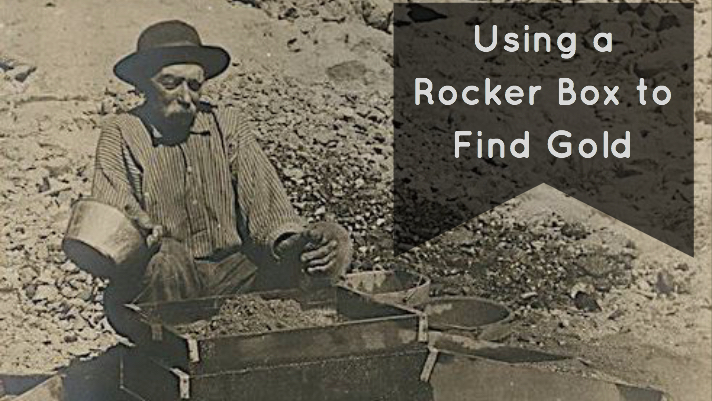
A rocker box is an tool that was commonly used during the early gold rush days. They were popular with miners who needed a piece of equipment that they could operate alone and with very little water. Used properly, they work by separating placer gold from the lighter sand and the gravel. There were also commonly called a cradle.
Building a rocker was relatively simple. Since they were primarily constructed of just wood, they were easy for individual miners to build and maintain. They were very popular tools during the early days. They are used much less frequently today, with the advancement of technology they are not as popular as they once were.
Lets take a look at the design and operation of the early rocker box, and why they were so important to the early miners.
Design of the Rocker Box
On the top of the box is a sieve or “grizzly.” It has openings of about half-inch or quarter-inch. This feature is very important; its main function is to screen the larger objects such as the bigger rock as well as other unwanted materials. While this might also accidentally screen out a large gold nugget, most of the time it was worthless pieces of gravel and rock that were rejected.
As the larger materials get sieved out, the only materials allowed to enter or pass through are much smaller pebbles or pieces of gold along with the finer sand and gravel which may contain more gold. By removing these larger rocks, the rocker box is able to operate more efficiently.
After the sieve, the box also consists of a part called a baffle. This is set right below the sieve. It is in between the sieve and the lower sluice section. Its main function is to act as another set of trap for the smaller and finer pieces of gold. It also ensures that there is an even distribution of the aggregate material being processed before it can finally reach the sluice section which does the final extraction process.
At the bottom end of the box from the inside are the riffles some type of cloth material that would capture the gold. Today miners get better results with material like miner’s moss or other specialty riffle material.

Design Variations
It is also important to note that rocker boxes can vary in design. Most of them used by early miners were homemade. An ideal box may have a combination of washing box with a screen, a canvas or carpet apron that is mounted right below the screen, a short sluice that can have two or more riffles and the rockers below the sluice.
The bottom end of the rocker can be made of the sheet of metal that comprises of holes that are punched in it with the diameter of about half-inch. Better still, half-inch-mesh screen can be put to use to increase the collection.
In order to use the sluice box effectively, one must ensure that its composites such as those discussed above are put in place and are well positioned so that each part can perform its duty properly.
Working the Material through the Rocker
After positioning all the composites rightly, the materials such as sand or gravel suspected to contain gold is collected in any container such as a bucket. Then, the content is placed on the top opening with a screen.
After that has been done, one can draw water in any container and start pouring it back and forth onto the content that has been fed on the opening of the box, while shaking the box back and forth. This is done in order to drive the finer gold content as well as smaller gold pieces through the sieve to the baffle. As a result, larger pieces of unwanted materials are also screened out.
From there, the larger pieces of rock and other unwanted materials trapped on the sieve can be removed to create more room for more materials to be screened if any. When that has been done, the baffle is removed to collect any gold pieces, and then washed into a gold pan filled with water to collect finer gravel than may contain gold.
Likewise, the retention material in the sluice section at the bottom of the box is also removed and washed to collect extra finer gold deposits. At the end of these processes, one should be able to collect some fine gold in the pan or any other container like a bucket used for washing off.
Also Read: Removing Black Sands – Final Gold Recovery with the Blue Bowl Concentrator
Rocker Boxes… A Lost Technique?
During the early gold rush, a rocker box was very efficient in gold collection, and they can still be used in areas with limited water with good results. Rocker boxes can be relatively efficient where it concerns trapping fine or flour gold.
Use of the rocker box has definitely faded over the past century. While it was a critical piece of mining equipment for its time, there are now other types of gear that are considerably better at gold recovery.
Rockers are also large and cumbersome, and similar or better results can be had using specialized sluice boxes and other equipment.
In a nutshell, a rocker box was once one of the major instruments used to collect gold by individual miners during the early days of the gold rush. You don’t see them every often today.
Next: The Monsters of the Goldfields – Bucket Line Dredges

